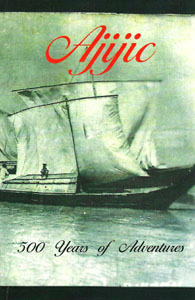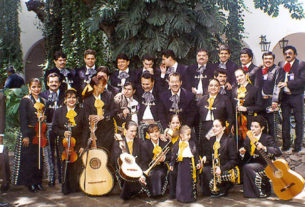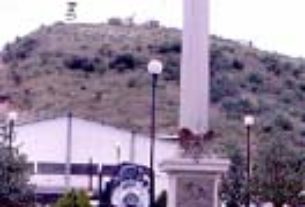Good Reading
 Ajijic: 500 Years of Adventures
Ajijic: 500 Years of Adventures
Produced by the Thomas Paine Chapter
National Society of the Daughters of the American Revolution
2011
This charming little book, put together by the Thomas Paine Chapter of the Daughters of the American Revolution, was compiled by long-term Ajijic residents Alexandra Bateman and Nancy Bollenbach. The Thomas Paine chapter of DAR, one of only a few in Mexico, was founded in Ajijic in 1999. Their book, Ajijic: 500 Years of Adventures, is the culmination of several years of effort: “A little idea grew into a demanding project. Compilers became authors, researchers, and translators as well as carrying the administrative load.” Indeed, it is a job well done.
The title announces that it is a history of “Ajijic: 500 Years of Adventures,” but in fact only the first three dozen pages (out of 150 pages) deal with history before the 20th century. Most of the book is a pleasant and satisfying collection of various articles, memoirs, interviews, about fairly recent life in Ajijic including Jocotepec and Chapala… life at Lakeside. Some of the accounts even contradict other accounts — did Porfirio Díaz really spend a few summers in Chapala, for example — but in the context of this book, mostly personal accounts of the past one hundred years at Lakeside, contradictions do not really matter.
One entire chapter, by Dale Hoyt Palfrey, is devoted to “The Checkered History of the Chapala Railway Station.” It gives us a detailed account of “Chapala’s most imposing landmark,” which opened in 1920 and served “its original purpose for only six years,” because of “political upheaval, economic crisis and the forces of nature.” The edifice has served various purposes since: in 1965 it was the birthplace of Lakeside Little Theatre, and in ensuing years it was “taken over by squatters and began falling into serious disrepair.” In 1991, the squatters were relocated to modest homes donated by the city and restoration began, continuing in fits and starts, until finally in 2006 the station was reborn as the Centro Cultural for the city of Chapala.
Other articles mention the talented writers who made the Lake Chapala area their home. D.H. Lawrence rented a house in Chapala where he wrote much of The Plumed Serpent. Neill James, author of many books including the Petticoat Vagabond series as well as Dust on My Heart, settled here permanently because her doctor had recommended Ajijic as a place to recuperate after she broke a leg climbing Popocatepetl. Neill James, of course, was instrumental in shaping the life of Ajijic as we know it… her commitment to the Mexican community became a model for other expatriates. The Lake Chapala Society now makes its home on her former estate. Zara Alexeyewa, the ballet dancer, wrote her autobiographical novel here, Quilocho and the Dancing Stars. Dane Chandos wrote Village in the Sun here. Erik Erikson came to Lakeside to work on Young Man Luther. Other authors who wrote at Lakeside include Vance Bourjaily, The Hound of Earth; Alexander Trocchi, Cain’s Book; Willard Marsh, Week with No Friday; Eileen Bassing, Home Before Dark and Where’s Annie (“which is interesting even today for the many Ajijic characters that people it”); Peter Elstob, Spanish Prisoner; and Witter Bynner, The Way of Life According to Lao Tzu.
The compilers themselves write that “The inspiration for this book came from several ‘do you remember’ conversations with old settlers….” Some of the most charming pieces in this book are the “stories of the adventurous people who arrived in the village, stayed and shaped their own lives and others.” Over half of the book is comprised of their stories, usually told either by themselves or their immediate descendants.
Laura Bateman first came to Mexico the summer of 1952, and she asserts that “Mexico has changed more in the past 40 years than it had for the preceding 400 years.” When she and her family arrived, there were only “about 15 other foreigners” living here. “In 1952 Ajijic had a population of 1200. Now it has 20,000. [Reviewers note: official estimates run around 10,000] In ’52 the village sported three cars and four trucks and my car.”
Throughout the book we discover interesting oddities. For example, Neill James, waiting outside the office of Maxwell Perkins of Scribners, witnessed “the notorious fist fight between Ernest Hemingway and Max Eastman.”
Katie Goodridge Ingram writes a chapter about her mother Helen Kirtland Goodridge who first came to Ajijic in 1945 after having lived in Mexico City, where “She used her gun many times to ward off burglars.” Life in Ajijic was simple then, “With no telephone, electricity, refrigeration, sewage, propane or running water…” Katie, incidentally, eventually converted the old adobe that her mother had refurbished and lived in — and where Katie lived and raised her children — into the popular shop, “Mi México,” which still displays and sells Mexican arts and crafts.
Joan Frost and her husband John arrived in Jocotepec in 1966, when “The mainly North American populations of Ajijic, Chapala, and Jocotepec in those days were retired military… colonels, admirals, and generals, including the general in charge of the German V1 and 2 base during World War II.
In the final chapter, Alexandra Bateman revisits the ’60s and ’70s. Even Timothy Leary lived here for awhile, renting “Zara’s mill house by the lake.” Werner Von Braun, technical director of the German rocket center at Peenemunde, spent time at Lake Chapala in the ’70s and Alexandra remembers that “My sister and I often ended up on the same bus with a very blond teenager who was his son.” Alexandra concludes the final chapter this way: “We have great hopes for the little village, the place where water flows.”
All in all, Ajijic: 500 Years of Adventures is a sweet little collection of bits of history and charming reminiscences that will provide you with some pleasant evenings, and for those of you who live at Lakeside and find stories about the community in which you live to be particularly fascinating, this book will be doubly pleasurable.
Also contributing to your pleasure might be the fact that the proceeds are used to provide scholarships for Mexican children and to provide support for projects like Needlepushers (which helps to clothe the children) and Have Hammers Will Travel (which teaches trades to young Mexicans).
Those interested in membership information for the Thomas Paine Chapter of the Daughters of the American Revolution should contact Sandra Loridans.
This book is out of print. If you are interested in the history of Ajijic, Tony Burton’s “Foreign Footprints in Ajijic: Decades of Change in a Mexican Village” offers a detailed account of how Ajijic changed during the twentieth century Available from Amazon Books: Paperback


